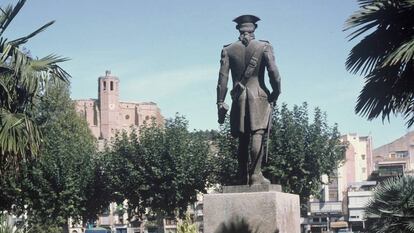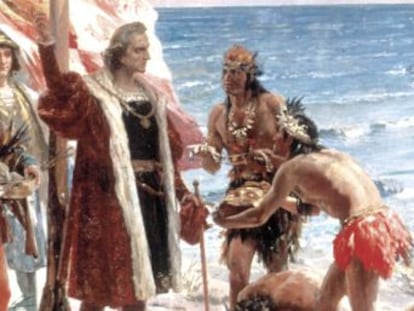The Catalans who conquered California
The Hispanic Council has revived the forgotten story of the Free Company of Volunteers of Catalonia, which was sent to defend the Pacific coast for Spain in the 1700s


The year was 1768. The normally peaceful expression on Spain’s King Charles III’s face turned into a grimace when he read the intelligence report: Russia was about to invade California, that uninhabited land north of the Viceroyalty of New Spain that had been discovered two and a half centuries earlier.
The Spanish monarch quickly rounded up some of his most notable aides: the Duke of Aranda, Gaspar Melchor de Jovellanos, and the Counts of Floridablanca and Campomanes.
The statesmen agreed on the need to definitively occupy the faraway territory, and appointed José de Gálvez to lead the effort. Gálvez did not hesitate: the military force on the ground would be the Free Company of Volunteers of Catalonia, headed by Gaspar de Portolá i Rovira, and made up of men who had been trained to face the “bellicose tribes” of the New World.
After a year and a half on the road, “provisions were noticeably low and the conditions increasingly grueling”
Their surprising story has now been retold in a publication by The Hispanic Council, a think tank that promotes ties between Spain and the Hispanic community in the United States. Titled Gaspar de Portolá y otros catalanes de la historia de España en Estados Unidos (or, Gaspar de Portolá and other Catalans in the history of Spain in the United States), it was written by the historian Borja Cardelús, who has authored numerous books about Spain’s presence in the Americas.
But the story begins earlier. After settling down in modern-day Mexico, the Spanish conquistador Hernán Cortés decided to explore the enormous body of water that lay west of the country, which Ferdinand Magellan had named the Pacific Ocean. This is how Europeans first set eyes on Baja and Alta California. In 1542, the sailor Juan Rodríguez Cabrillo found the bay of San Diego.
His successor, Bartolomé Ferrelo, reached Oregon. And in 1602, the Spaniard Sebastián Vizcaíno set sail with a fleet of three ships to make “a meticulous cartographical record of the coastline” and concluded that the bay of Monterrey, in present-day United States, would be a “very favorable” spot for a military settlement. His maps were kept in a secret location to make sure they wouldn’t fall into English hands. At that point, Spain’s interest in those lands had begun to dwindle – until 1768.
That year, Charles III’s military and religious expedition used those old maps to locate Monterrey and build a permanent settlement to use as a home base from which to conquer – and evangelize – California. Captain Portolá and his Catalan volunteers headed the military expedition up the Pacific coast, while Friar Junípero Serra was in charge of the religious side of the mission.
But after a year and a half on the road, “provisions were noticeably low and the conditions increasingly grueling.” And still there was no sign of the bay of Monterrey. The group concluded that either Vizcaíno had made a mistake, or the cove had disappeared. They had to go back to Mexico if they didn’t want to starve to death, as the ships meant to supply the land contingent with food were nowhere in sight.
But Friar Junípero Serra refused to turn back: “The Indians could not be left without evangelizing,” writes Cardelús. Portolá and the friar got caught up in a heated argument. The former agreed to four more days, after which they would turn back because of the “trail of dead left by the hunger.”
The company’s leaders and soldiers were drawn preferentially from Catalonia, although those born in other Spanish provinces and Europe could also be admitted
On the fourth day, as the expedition was getting ready to retrace its steps, the San Antonio ship showed up on the horizon, laden with provisions. Soon after that they found Monterrey “at the exact and precise spot indicated by Sebastián Vizcaíno’s excellent map.”
Gaspar de Portolá was named governor of Puebla de los Ángeles (Mexico), then the king’s lieutenant in Lleida, in Catalonia, where he had returned in 1784. He died in 1786, and his military service record reads: “He fulfilled his orders and showed courage and good conduct.”
The Free Company of Volunteers of Catalonia was founded in Barcelona in 1767 and it was sent to New Spain due to its courage and “the bellicose attitude of some Indian tribes.” Its leaders and soldiers were drawn preferentially from Catalonia, although those born in other Spanish provinces and Europe could also be admitted.
The Hispanic Council’s publication ends by noting that “not infrequently it has been said that the American adventure was reserved for the subjects of Castile, and that those under the Crown of Aragón were deliberately excluded. Nothing could be further from the truth, as the number of Catalans who participated in the Americas project is immense.”
English version by Susana Urra.
Tu suscripción se está usando en otro dispositivo
¿Quieres añadir otro usuario a tu suscripción?
Si continúas leyendo en este dispositivo, no se podrá leer en el otro.
FlechaTu suscripción se está usando en otro dispositivo y solo puedes acceder a EL PAÍS desde un dispositivo a la vez.
Si quieres compartir tu cuenta, cambia tu suscripción a la modalidad Premium, así podrás añadir otro usuario. Cada uno accederá con su propia cuenta de email, lo que os permitirá personalizar vuestra experiencia en EL PAÍS.
¿Tienes una suscripción de empresa? Accede aquí para contratar más cuentas.
En el caso de no saber quién está usando tu cuenta, te recomendamos cambiar tu contraseña aquí.
Si decides continuar compartiendo tu cuenta, este mensaje se mostrará en tu dispositivo y en el de la otra persona que está usando tu cuenta de forma indefinida, afectando a tu experiencia de lectura. Puedes consultar aquí los términos y condiciones de la suscripción digital.
More information
Últimas noticias
Most viewed
- Sinaloa Cartel war is taking its toll on Los Chapitos
- Oona Chaplin: ‘I told James Cameron that I was living in a treehouse and starting a permaculture project with a friend’
- Reinhard Genzel, Nobel laureate in physics: ‘One-minute videos will never give you the truth’
- Why the price of coffee has skyrocketed: from Brazilian plantations to specialty coffee houses
- Silver prices are going crazy: This is what’s fueling the rally










































